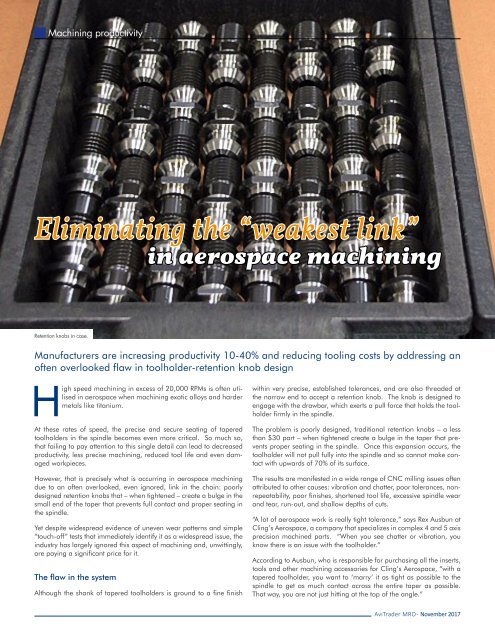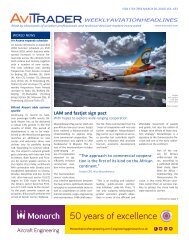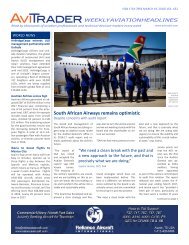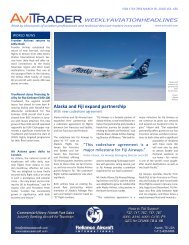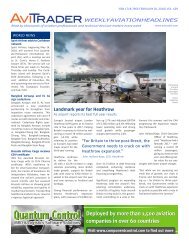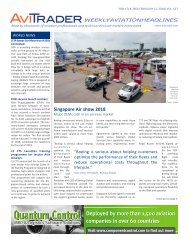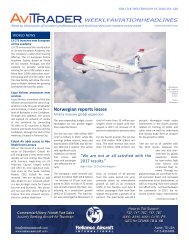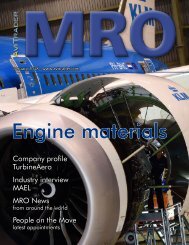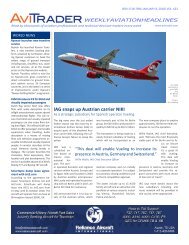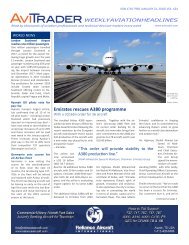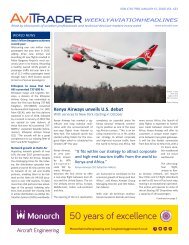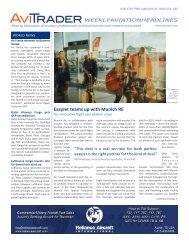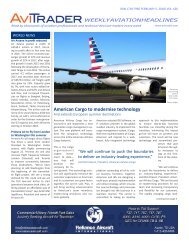AviTrader_Monthly_MRO_e-Magazine_2017-11
AviTrader_Monthly_MRO_e-Magazine_2017-11
AviTrader_Monthly_MRO_e-Magazine_2017-11
You also want an ePaper? Increase the reach of your titles
YUMPU automatically turns print PDFs into web optimized ePapers that Google loves.
Machining productivity<br />
25<br />
Eliminating the “weakest link”<br />
in aerospace machining<br />
Retention knobs in case.<br />
Manufacturers are increasing productivity 10-40% and reducing tooling costs by addressing an<br />
often overlooked flaw in toolholder-retention knob design<br />
H<br />
igh speed machining in excess of 20,000 RPMs is often utilised<br />
in aerospace when machining exotic alloys and harder<br />
metals like titanium.<br />
At these rates of speed, the precise and secure seating of tapered<br />
toolholders in the spindle becomes even more critical. So much so,<br />
that failing to pay attention to this single detail can lead to decreased<br />
productivity, less precise machining, reduced tool life and even damaged<br />
workpieces.<br />
However, that is precisely what is occurring in aerospace machining<br />
due to an often overlooked, even ignored, link in the chain: poorly<br />
designed retention knobs that – when tightened – create a bulge in the<br />
small end of the taper that prevents full contact and proper seating in<br />
the spindle.<br />
Yet despite widespread evidence of uneven wear patterns and simple<br />
“touch-off” tests that immediately identify it as a widespread issue, the<br />
industry has largely ignored this aspect of machining and, unwittingly,<br />
are paying a significant price for it.<br />
The flaw in the system<br />
Although the shank of tapered toolholders is ground to a fine finish<br />
within very precise, established tolerances, and are also threaded at<br />
the narrow end to accept a retention knob. The knob is designed to<br />
engage with the drawbar, which exerts a pull force that holds the toolholder<br />
firmly in the spindle.<br />
The problem is poorly designed, traditional retention knobs – a less<br />
than $30 part – when tightened create a bulge in the taper that prevents<br />
proper seating in the spindle. Once this expansion occurs, the<br />
toolholder will not pull fully into the spindle and so cannot make contact<br />
with upwards of 70% of its surface.<br />
The results are manifested in a wide range of CNC milling issues often<br />
attributed to other causes: vibration and chatter, poor tolerances, nonrepeatability,<br />
poor finishes, shortened tool life, excessive spindle wear<br />
and tear, run-out, and shallow depths of cuts.<br />
“A lot of aerospace work is really tight tolerance,” says Rex Ausbun at<br />
Cling’s Aerospace, a company that specializes in complex 4 and 5 axis<br />
precision machined parts. “When you see chatter or vibration, you<br />
know there is an issue with the toolholder.”<br />
According to Ausbun, who is responsible for purchasing all the inserts,<br />
tools and other machining accessories for Cling’s Aerospace, “with a<br />
tapered toolholder, you want to ‘marry’ it as tight as possible to the<br />
spindle to get as much contact across the entire taper as possible.<br />
That way, you are not just hitting at the top of the angle.”<br />
<strong>AviTrader</strong> <strong>MRO</strong> - November <strong>2017</strong>


